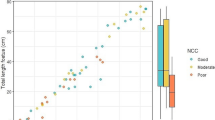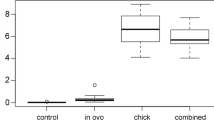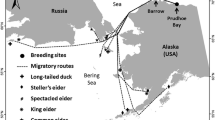Abstract
The body load of tDDT (p,p′DDT + o,p′DDT + p,p′DDE+p,p′TDE) and polychlorinated biphenyls (sum of congeners) was estimated for 169 fin whales to study age and sex-related variation and to calculate the quantity of these compounds transferred to offspring through reproduction. Blubber was the body compartment containing the greatest quantities of organochlorines, but its relative contribution to total load was lower than in other cetaceans because in fin whales muscle and bone are also significant lipid reserve sites. In male fin whales, organochlorine body loads increased with age but tended to reach a plateau in fully grown individuals. In adult females, loads decreased with age because of transfer to offspring canceling the rise in loads associated with body growth; as a consequence, the amount of organochlorines transferred during a reproductive cycle also declined with age. This transfer is lower than that found for other cetaceans because fin whales have a shorter lactation period. According to the calculations, the first offspring of a female fin whale receives about 1 g of PCB and about 1.5 g of tDDT. These amounts will progressively decrease in subsequent reproductive cycles to reach a minimum of 0.2 g PCB and 0.3 g tDDT in an old female. Therefore, the first calf delivered is the one most likely to be affected by pollutants.
Similar content being viewed by others
References
Abarnou A, Robineau D, Michel P (1986) Contamination par les organochlorés des dauphins de Commerson des iles Kerguelen. Oceanol Acta 9(1):19–29
Addison RF, Brodie PF (1977) Organochlorine residues in maternal blubber from grey seals (Halichoerus grypus) from Sable Island, Nova Scotia. J Fish Res Board Can 34(7):937–941
—, — (1987) Transfer of organochlorine residues from blubber through the circulatory system to milk in the lactating grey seal Halichoerus grypus. Can J Fish Aquat Sci 44(4):782–786
Aguilar A (1983) Organochlorine pollution in sperm whales, Physeter macrocephalus, from the temperate waters of the Eastern North Atlantic. Mar Poll Bull 14(9):349–352
-- (1985a) Biología y dinámica poblacional del rorcual común (Balaenoptera physalus) en las aguas atlánticas ibéricas. Ph D Dissertation, University of Barcelona, 487 pp
— (1985b) Compartmentation and reliability of sampling procedures in organochlorine pollution surveys of cetaceans. Residue Rev 95:91–114
— (1987) Using organochlorine pollutants to discriminate marine mammal populations: a review and critique of the methods. Mar Mamm Sci 3(3):242–262
—, Borrell A (1988) Age- and sex-related changes in organochlorine compound levels in fin whales (Balaenoptera physalus) from the eastern North Atlantic. Mar Environ Res 25:195–211
—, — (1991) Heterogeneous distribution of organochlorine contaminants in the blubber of large whales: implications for sampling procedures. Mar Environ Res 31:275–286
—, Olmos M, Lockyer C (1988) Sexual maturity in fin whales (Balaenoptera physalus) caught off Spain. Rep int Whal Commn 38:317–322
Alzieu C, Duguy R (1979) Teneurs en composés organochlorés chez les cétacés et pinnipèdes frequentant les côtes françaises. Oceanol Acta 2(1):107–120
Ando M (1978) Transfer of 2,4,5,2′,4′,5′-hexachlorobiphenyl and 2,2-bis-(p-chlorophenyl), 1,1,1-trichloroethane (p,p′-DDT) from maternal to newborn and suckling rats. Arch Toxicol 41:179–186
Bergman A, Olsson M, Reiland S (1992) Skull-bone lesions in the Baltic grey seal (Halichoerus grypus). Ambio 21(8):517–519
Bleavins MR, Breslin WJ, Aulerich RJ, Ringer RK (1984) Placental and mammary transfer of a polychlorinated biphenyl mixture (Aroclor® 1254) in the European ferret (Mustela putorius furo). Environ Toxicol Chem 3:637–644
Borrell A (1993) PCB and DDTs in blubber of cetaceans from the northeastern North Atlantic. Mar Pollut Bull 26(3):146–151
—, Aguilar A (1987) Variations in DDE percentage correlated to total DDT burden in the blubber of fin and sci whales. Mar Pollut Bull 18(20):70–74
Clausen B, Andersen S (1988) Evaluation of bycatch and health status of the harbour porpoise (Phocoena phocoena) in Danish waters. Dan Rev Game Biol 13(5):1–20
Cockcroft VG, de Kock AC, Lord AD, Ross GJB (1989) Organochlorines in bottlenose dolphins Tursiops truncatus from the east coast of South Africa. S Afr J Mar Sci 8:207–217
Curley A, Copeland MF, Kimbrough RD (1969) Chlorinated hydrocarbon insecticides in organs of stillborn and blood of newborn babies. Arch Environ Health 19:628–632
Duinker JC, Hillebrand MTH (1979) Mobilization of organochlorines from female lipid tissue and transplacental transfer to fetus in a harbour porpoise (Phocoena phocoena) in a contaminated area. Bull Environ Contam Toxicol 23:728–32
—, —, Zeinstra T, Boon JP (1989) Individual chlorinated biphenyls and pesticides in tissues of some cetacean species from the North Sea and the Atlantic Ocean; tissue distribution and biotransformation. Aquat Mamm 15(3):95–124
Faber JJ, Thornburg KL, Binder ND (1992) Physiology of placental transfer in mammals. Am Zool 32:343–354
Fukushima M, Kawai S (1981) Variation of organochlorine residue concentration and burden in striped dolphin (Stenella coeruleoalba) with growth. In: Fujiyama T (ed) Studies on the levels of organochlorine compounds and heavy metals in the marine organisms. University of the Ryukyus, Okinawa, pp 97–114
Fuller GB, Hobson WC (1986) Effects of PCBs on reproduction in mammals. In: PCBs and the environment. CRC Press, Boca Raton, FL Vol 3, pp 101–125
Gaskin DE, Holdrinet M, Frank R (1982) DDT residues in blubber of harbour porpoise, Phocoena phocoena (L.), from Eastern Canadian waters during the five-year period 1969–73. In: Mammals in the seas. FAO Fisheries Series 5(4), pp 135–143
—, Frank R, Holdrinet M (1983) Polychlorinated biphenyls in harbour porpoises, Phocoena phocoena (L.), from the Bay of Fundy, Canada and adjacent waters, with some information on chlordane and hexachlorobenzene levels. Arch Environ Contam Toxicol 12:112–119
Hayes WJ (1975) Toxicology of pesticides. Williams and Wilkins Co, Baltimore, MD, 475 pp
Hidaka H, Tanabe S, Tatsukawa R (1983) DDT compounds and PCB isomers and congeners in Weddell seals and their fate in the Antarctic marine ecosystem. Agric Biol Chem 47(9):2009–2017
Juchau MR (1983) Disposition of chemical contaminants in maternal-embryonic/fetal systems. In: Hazard assessment of chemicals. Current Developments Vol 2. Academic Press, NY, pp 95–132
Kihlstrom JE, Olsson M, Jensen S, Johansson A, Ahlbom J, Bergman A (1992) Effects of PCB and different fractions of PCB on the reproduction of the mink (Mustela vison). Ambio 21(8):563–569
Lockyer C (1976) Body weights of some species of large whales. J Cons Int Explor Mer 36(3):259–273
— (1984) Age determination by means of the ear plug in baleen whales. Rep int Whal Commn 34:692–696
—, Waters T (1986) Weights and anatomical measurements of northeastern Atlantic fin (Balaenoptera physalus, Linnaeus) and sei (B. borealis, Lesson) whales. Mar Mamm Sci 2(3):169–185
Marsh H, Kasuya T (1986) Evidence for reproductive senescence in female cetaceans. Rep int Whal Commn (Sp Iss 8):57–74
Mead JG, Odell DK, Wells RS, Scott MD (1980) Observations on a mass stranding of spinner dolphins, Stenella longirostris, from the west coast of Florida. Fish Bull 78(2):353–360
Miyazaki N, Nakamura I, Tanabe S, Tatsukawa R (1987) A stranding of Mesoplodon Stejnegeri in the Maizuru Bay, Sea of Japan. Sci Rep Whales Res Inst Tokyo 38:91–105
—, Nakayama K (1989) Records of cetaceans in the waters of the Amami Islands. Mem Nat Sci Mus 22:235–249
Morris RJ, Law RJ, Allchin CR, Kelly CA, Fileman CF (1989) Metals and organochlorines in dolphins and porpoises of Cardigan Bay, West Wales. Mar Pollut Bull 20(10):512–523
Morrisey RE, Schwetz BA (1989) Reproductive and developmental toxicity in animals. In: Kimbrough RD, Jensen AA (eds) Halogenated biphenyls, terphenyls, naphtalenes, dibenzodioxins and related products. Elsevier, Amsterdam, pp 195–225
Muir DCG, Ford CA, Stewart REA, Smith TG, Addison RF, Zinck ME, Béland P (1990) Organochlorine contaminants in belugas, Delphinapterus leucas, from Canadian waters. Can Bull Fish Aquat Sci 224:165–190
Perrin WF, Reilly SB (1984) Reproductive parameters of dolphins and small whales of the family Delphinidae. Rep int Whal Commn (Sp Iss 6):97–125
Reijnders PJH (1986) Reproductive failure in common seals feeding on fish from polluted coastal waters. Nature (London) 324:456–457
Ross GJB (1984) The smaller cetaceans of the South East coast of southern Africa. Ann Cape Prov Mus (Nat Hist) 15(2):173–410
Saschenbrecker PW (1973) Levels of DDT and PCB compounds in North Atlantic fin-back whales. Can J Comp Med 37:203–206
Tanabe S, Tatsukawa R, Tanaka H, Maruyama K, Miyazaki N, Fujiyama T (1981) Distribution and total burdens of chlorinated hydrocarbons in bodies of striped dolphins (Stenella coeruleoalba). Agric Biol Chem 45(11):2569–2578
—, —, Maruyama K, Miyazaki N (1982) Transplacental transfer of PCBs and chlorinated pesticides from the pregnant striped dolphin (Stenella coeruleoalba) to her fetus. Agric Biol Chem 46(5):1249–1254
--, Miura S, Tatsukawa R (1985) Variations of organochlorine residues with age and sex in Antarctic minke whale. Mem Natl Inst Polar Res Sp Iss 44:174–81
Thomas PT, Hinsdill RD (1980) Perinatal PCB exposure and its effect on the immune system of young rabbits. Drug Chem Toxicol 2:1–4
Turner JC (1979) Transplacental movement of organochlorine pesticide residues in desert bighorn sheep. Bull Environ Contam Toxicol 21:116–124
Author information
Authors and Affiliations
Rights and permissions
About this article
Cite this article
Aguilar, A., Borrell, A. Reproductive transfer and variation of body load of organochlorine pollutants with age in fin whales (Balaenoptera physalus). Arch. Environ. Contam. Toxicol. 27, 546–554 (1994). https://doi.org/10.1007/BF00214848
Received:
Revised:
Issue Date:
DOI: https://doi.org/10.1007/BF00214848




